A Guide to the Best Varieties of Weeping Cherry Trees to Plant in Your Garden
Published: November 9, 2025 at 12:07:06 AM UTC
Weeping cherry trees stand as living sculptures in the landscape, their gracefully cascading branches creating a waterfall of blossoms each spring. These ornamental treasures combine the delicate beauty of cherry blossoms with a uniquely pendulous growth habit that adds year-round visual interest to any garden. Whether you're looking to create a stunning focal point, add seasonal color, or bring a touch of Japanese garden aesthetics to your landscape, weeping cherry trees offer unmatched elegance and charm that few other ornamental trees can match.

With several distinct varieties available, each with its own unique characteristics, selecting the right weeping cherry for your garden requires understanding their differences in size, bloom color, hardiness, and care requirements. This guide will walk you through the most popular and garden-worthy weeping cherry varieties, helping you choose the perfect specimen to enhance your outdoor space for decades to come.
Understanding Weeping Cherry Trees
Weeping cherry trees are ornamental specimens created through specialized grafting techniques. Most varieties are the result of grafting weeping or cascading cherry cultivars onto upright cherry rootstock. This horticultural practice produces trees with a distinctive form where branches grow downward rather than upward or outward.
The weeping habit is not naturally occurring in most cherry species but is instead the result of centuries of selective breeding, particularly in China and Japan where these trees hold cultural significance. All true weeping cherries share similar growing attributes because they are created by grafting different tops onto the same type of rootstock.
What makes these trees special is not just their form but their spectacular spring display. Different varieties bloom at slightly different times throughout spring, with some flowering as early as March in warmer climates. While weeping cherries produce small fruits, they are grown primarily for ornamental purposes rather than fruit production.
The tradition of cultivating weeping cherry trees dates back hundreds of years in Japan, where they're known as "shidare-zakura" and are central to the cultural celebration of cherry blossom season (Hanami).
Top Weeping Cherry Tree Varieties for Home Gardens
Each weeping cherry variety offers unique characteristics in terms of size, bloom color, and growth habit. Here are the most popular and garden-worthy varieties to consider for your landscape:
1. Falling Snow Weeping Cherry (Prunus 'Snofozam')
The Falling Snow weeping cherry is prized for its neat, symmetrical shape with branches that cascade almost straight down. Its dense white blossoms create a spectacular display in early spring, often being the first of the weeping cherry varieties to flower.
- Bloom Color: Pure white
- Bloom Time: Very early spring
- Mature Size: 8-15 feet tall and 6-12 feet wide
- Hardiness Zones: 5-8
- Special Features: Earliest blooming variety, compact size ideal for smaller gardens
This variety is particularly well-suited for courtyard gardens and smaller spaces. Many gardeners choose to grow them in large containers with a shorter stem to keep the beautiful blossoms at eye level for maximum enjoyment.
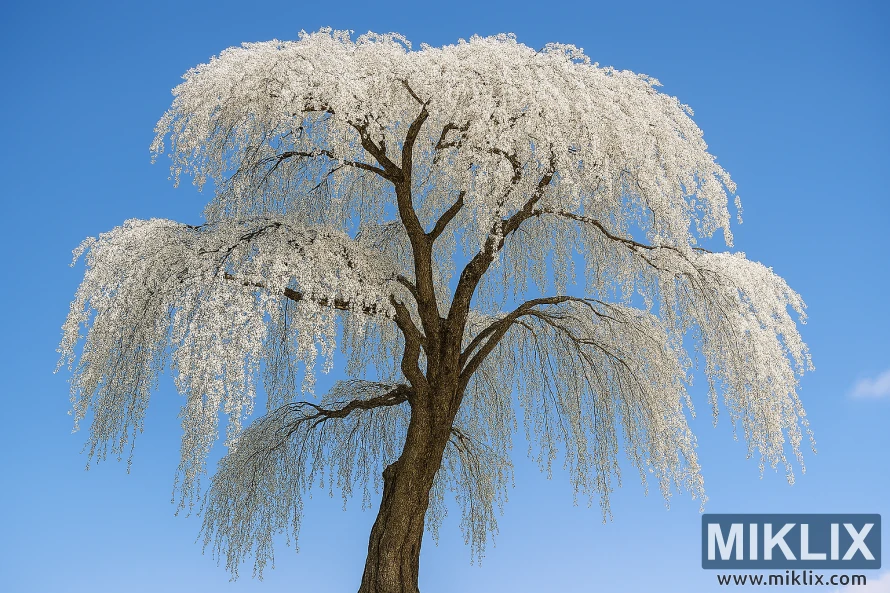
2. Subhirtella Alba Weeping Cherry (Prunus subhirtella 'Pendula Alba')
The Subhirtella Alba (often called "Sub Alba" by nursery professionals) features flowers that aren't purely white but have a hint of soft pink. Its blossoms are notably larger than those of the Falling Snow variety, creating an overwhelming display when in full bloom.
- Bloom Color: White with soft pink tinge
- Bloom Time: Mid-spring
- Mature Size: 15-20 feet tall and 15-25 feet wide
- Hardiness Zones: 4-8
- Special Features: Larger flowers, excellent disease resistance, beautiful autumn color
This variety tends to grow wider than the Falling Snow, developing a more spreading habit over time. It's exceptionally hardy, resistant to wind and heat, and less prone to pests and diseases than other varieties. The foliage provides excellent autumn color before dropping.
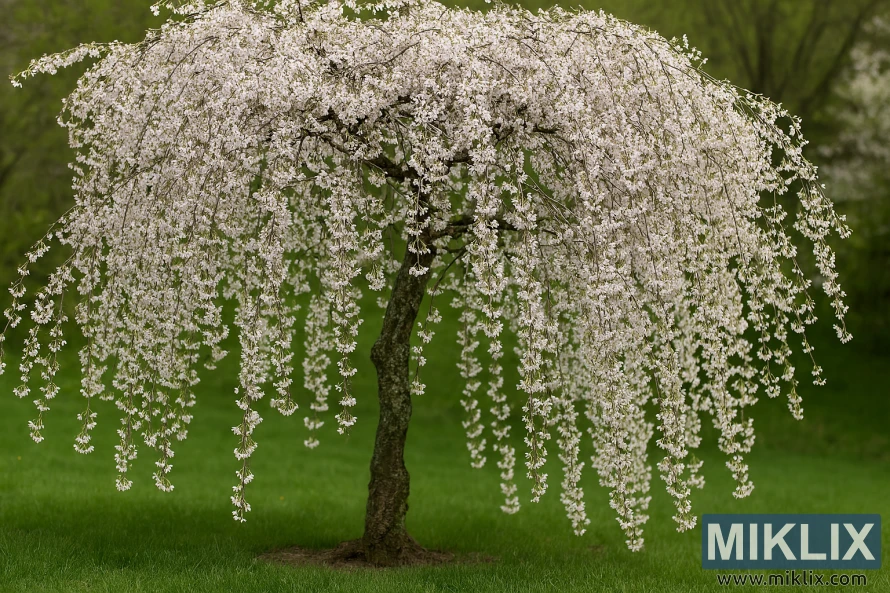
3. Subhirtella Rosea Weeping Cherry (Prunus subhirtella 'Pendula Rosea')
The Subhirtella Rosea (or "Sub Rosea") is known for its beautiful, soft pink blossoms and impressive size. When in full bloom, it creates a spectacular cloud-like canopy of pink flowers that can grow quite large over time.
- Bloom Color: Soft pink
- Bloom Time: Mid to late spring
- Mature Size: 15-25 feet tall and up to 30 feet wide
- Hardiness Zones: 4-8
- Special Features: Largest flower display, creates a canopy effect when mature
This variety can develop an impressive spread of up to 3-3.5 meters wide, though it can be controlled through pruning. It's highly adaptable to various growing conditions including heat and moderate drought, but performs best when protected from strong winds that might damage its blossoms.
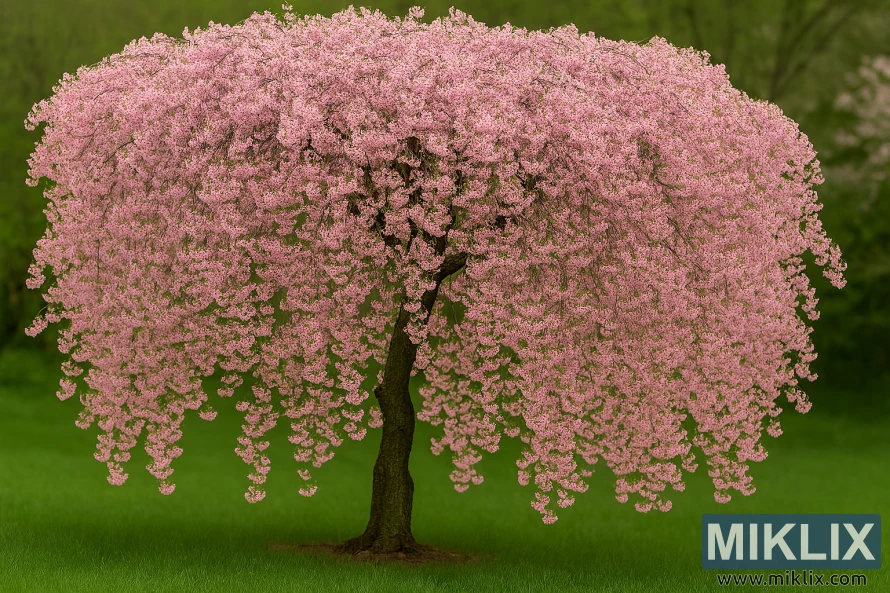
4. Cheals Weeping Cherry (Prunus 'Kiku-shidare-zakura')
The Cheals weeping cherry is one of the last varieties to blossom in spring. It features beautiful double-petaled pink flowers that completely cover its bare, loosely hanging branches when in bloom.
- Bloom Color: Deep pink with double petals
- Bloom Time: Late spring
- Mature Size: 10-15 feet tall and 15-20 feet wide
- Hardiness Zones: 5-8
- Special Features: Unique irregular growth habit, double flowers, excellent autumn color
What makes the Cheals weeping cherry truly unique is its irregular growth pattern. Unlike other varieties that grow in a predictable way, the Cheals can have some branches cascading down while others grow outward or even upward, creating an asymmetrical, character-filled appearance that stands out in the landscape.
In autumn, this variety develops beautiful bronze foliage, adding seasonal interest. Like all weeping cherries, it performs best in a location protected from strong winds.
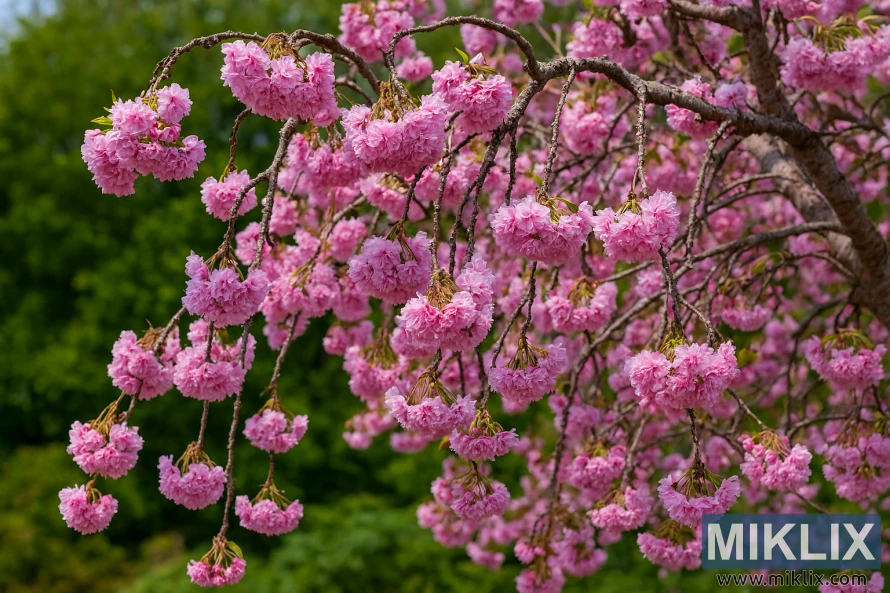
5. Mount Fuji Cherry (Prunus serrulata 'Shirotae')
While not a true "weeping" cherry in the strictest sense, the Mount Fuji cherry (also known as Shirotae or "snow white") is often grouped with weeping varieties due to its horizontal spreading habit. Instead of cascading downward, its branches grow outward in a broad, horizontal manner.
- Bloom Color: Pure white double flowers
- Bloom Time: Mid-spring
- Mature Size: 15-20 feet tall and 20-30 feet wide
- Hardiness Zones: 5-8
- Special Features: Horizontal spreading habit, fragrant flowers in hanging clusters
The Mount Fuji cherry produces spectacular white double flowers that grow in hanging bunches of five to seven blossoms. Its branches can spread quite wide, sometimes reaching 3-4 meters, making it an excellent choice for creating areas of dappled shade in the garden.
This variety works particularly well in cottage garden settings where you can plant flowering perennials beneath its broad canopy.

6. Higan Weeping Cherry (Prunus subhirtella 'Pendula')
The Higan weeping cherry is one of the most cold-hardy varieties, making it an excellent choice for northern gardens. It features single pink blossoms that appear in early spring, often before the leaves emerge.
- Bloom Color: Light pink single flowers
- Bloom Time: Early to mid-spring
- Mature Size: 20-30 feet tall and 15-25 feet wide
- Hardiness Zones: 4-8
- Special Features: Excellent cold hardiness, long-lived, attracts pollinators
This variety is known for its reliability and longevity, with many specimens living for 50+ years when properly sited and cared for. The small fruits that follow the flowers are beloved by birds, making this tree valuable for wildlife gardens.
The Higan cherry's branches cascade gracefully to the ground, creating a classic weeping form that makes it an ideal specimen or focal point tree.

7. Snow Fountains Weeping Cherry (Prunus 'Snofozam')
The Snow Fountains weeping cherry is a compact variety that's perfect for smaller gardens and spaces where other weeping cherries might be too large. Its branches cascade dramatically to the ground, creating a fountain-like appearance when covered in pure white blossoms.
- Bloom Color: Bright white
- Bloom Time: Early spring
- Mature Size: 8-15 feet tall and 6-8 feet wide
- Hardiness Zones: 5-8
- Special Features: Compact size, dramatic weeping habit, suitable for containers
This variety can be trained to different heights depending on how high it's grafted, making it versatile for various landscape applications. Its smaller size makes it suitable for container growing on patios or in courtyard gardens.
Snow Fountains develops attractive bronze-red fall color, providing multi-season interest in the landscape.

Planting and Care Guide for Weeping Cherry Trees
Ideal Growing Conditions
Sunlight Requirements
Weeping cherry trees perform best in full sun locations that receive at least 6 hours of direct sunlight daily. While they can tolerate partial shade, flowering will be reduced in too much shade. Morning sun with afternoon shade is ideal in hotter climates to protect the tree from heat stress.
Soil Conditions
These trees prefer well-drained, fertile soil with a slightly acidic to neutral pH (6.0-7.0). They will not tolerate soggy conditions, so avoid planting in areas with poor drainage or heavy clay soil unless you amend it substantially with organic matter or plant on a slight mound to improve drainage.
Planting Instructions
- Timing: Plant in early spring or fall when the tree is dormant for best results.
- Site preparation: Dig a hole twice as wide as the root ball but no deeper than the root ball's height.
- Soil amendment: Mix the native soil with quality compost or planting mix at a ratio of about 70% native soil to 30% amendments.
- Positioning: Place the tree in the hole so the graft union (visible swelling on the trunk) is 2-3 inches above the soil line.
- Backfilling: Carefully fill in around the roots, gently tamping down to remove air pockets.
- Watering: Create a water basin around the tree and water thoroughly after planting.
- Mulching: Apply 2-3 inches of mulch in a circle around the tree, keeping it away from the trunk.
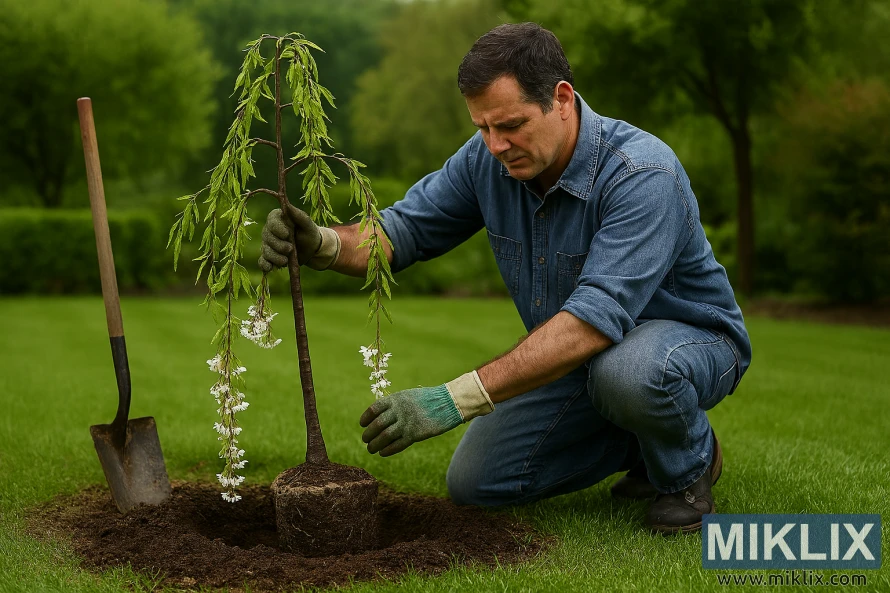
Ongoing Care
Watering
Water deeply once a week during the first growing season. In subsequent years, water during dry spells, providing about 1 inch of water weekly. While established trees can tolerate some drought, regular watering during extended dry periods will keep them healthier and more resistant to pests and diseases.
Fertilization
Apply a balanced, slow-release fertilizer formulated for flowering trees in early spring before new growth begins. Avoid fertilizing after midsummer as this can stimulate late-season growth that may be damaged by winter cold. A layer of compost applied annually can also provide nutrients.
Pruning
Prune weeping cherries immediately after flowering to avoid removing next year's flower buds. Remove any dead, damaged, or diseased branches, as well as any suckers growing from the rootstock below the graft. Thin out crowded areas to improve air circulation, but maintain the natural weeping form.
Important: Always remove any suckers that grow from the base of the tree or from the rootstock below the graft union. These will not have the weeping characteristic and can eventually take over the tree if left unchecked.
Design Ideas for Incorporating Weeping Cherry Trees
Focal Point Planting
Position a weeping cherry as a specimen tree in the center of a front yard or in a prominent location visible from main living areas. The dramatic silhouette creates a natural focal point, especially when underplanted with spring bulbs or low-growing perennials that complement the blooms.
Japanese Garden Feature
Incorporate weeping cherries into Japanese-inspired gardens alongside elements like stone lanterns, bamboo, and water features. The Mount Fuji or Higan varieties work particularly well in this setting, creating authentic Asian garden aesthetics.
Waterside Planting
Plant weeping cherries near ponds, streams, or reflecting pools where their cascading branches and blossoms can be mirrored in the water. This doubles the visual impact and creates a serene, contemplative garden space.
Courtyard Tree
Smaller varieties like Falling Snow or Snow Fountains make excellent choices for intimate courtyard gardens. Their compact size won't overwhelm the space, while their weeping form creates a sense of enclosure and privacy.
Container Specimen
Dwarf weeping cherries can be grown in large containers on patios or terraces. Choose a container at least 24 inches in diameter and ensure it has adequate drainage. This approach works well for smaller gardens or urban spaces.
Seasonal Garden Highlight
Plant different weeping cherry varieties with sequential bloom times to extend the flowering season. Combine early, mid, and late-blooming varieties for weeks of continuous blossom display throughout spring.
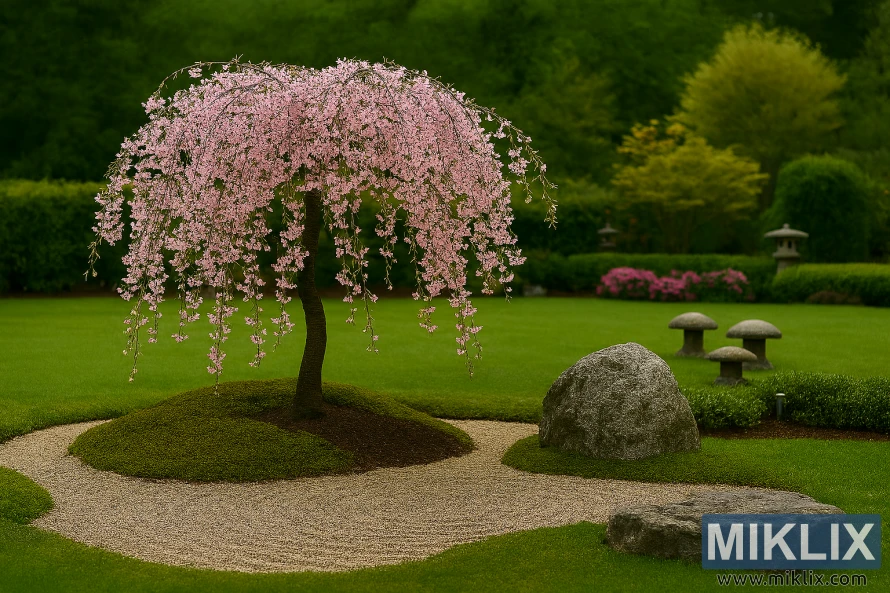
Troubleshooting Common Problems
Prevention Tips
- Plant in well-drained soil with proper spacing for air circulation
- Water at the base of the tree rather than overhead to prevent fungal issues
- Apply mulch to regulate soil temperature and moisture
- Inspect regularly for early signs of problems
- Remove fallen leaves and debris that may harbor disease
- Prune only after flowering using clean, sharp tools
Common Issues
- Leaf spot diseases (brown or black spots on foliage)
- Powdery mildew (white powdery coating on leaves)
- Bacterial canker (oozing sap and branch dieback)
- Borers (small holes in trunk with sawdust-like material)
- Aphids (clusters of small insects on new growth)
- Root rot in poorly drained soils
Treating Specific Problems
How do I treat leaf spot diseases?
Leaf spots are typically fungal issues that thrive in wet conditions. Improve air circulation by thinning branches and avoid overhead watering. Remove and destroy affected leaves. Apply a fungicide labeled for cherry trees at the first sign of infection, following package directions carefully.
What should I do about aphids on my weeping cherry?
Aphids can be controlled with a strong spray of water to dislodge them or by introducing beneficial insects like ladybugs. For more severe infestations, use insecticidal soap or neem oil, applying in the evening when beneficial insects are less active. Repeat applications may be necessary.
How can I prevent bacterial canker?
Bacterial canker is difficult to treat once established. Prevention is key: avoid pruning in wet weather, sterilize pruning tools between cuts, and ensure proper fertilization (avoid excessive nitrogen). If canker appears, prune affected branches at least 6 inches below visible symptoms during dry weather.
Why is my weeping cherry not flowering well?
Poor flowering can result from several factors: insufficient sunlight, improper pruning timing (removing flower buds), young tree age, or late spring frosts damaging buds. Ensure your tree receives at least 6 hours of sun daily, prune only after flowering, and consider protecting young trees from late frosts with covers if necessary.

Conclusion
Weeping cherry trees represent some of the most beautiful ornamental specimens available for home gardens. Their graceful, cascading form creates living sculpture in the landscape, while their spectacular spring blossoms provide an unforgettable seasonal display that few other trees can match.
When selecting a weeping cherry variety for your garden, consider not only the bloom color and timing but also the mature size, growth habit, and specific site conditions. With proper planting and care, these magnificent trees can thrive for decades, becoming beloved landmarks in your landscape that provide year-round beauty and interest.
Whether you choose the early-blooming Falling Snow with its pure white flowers, the impressive pink cloud of the Subhirtella Rosea, or the unique character of the Cheals with its irregular branching, a weeping cherry tree is an investment in garden beauty that will reward you with decades of enjoyment and create a legacy for future generations to appreciate.

Further Reading
If you enjoyed this post, you may also like these suggestions:
- Best Beech Trees for Gardens: Finding Your Perfect Specimen
- Best Oak Trees for Gardens: Finding Your Perfect Match
- The Best Linden Tree Varieties to Plant in Your Garden
